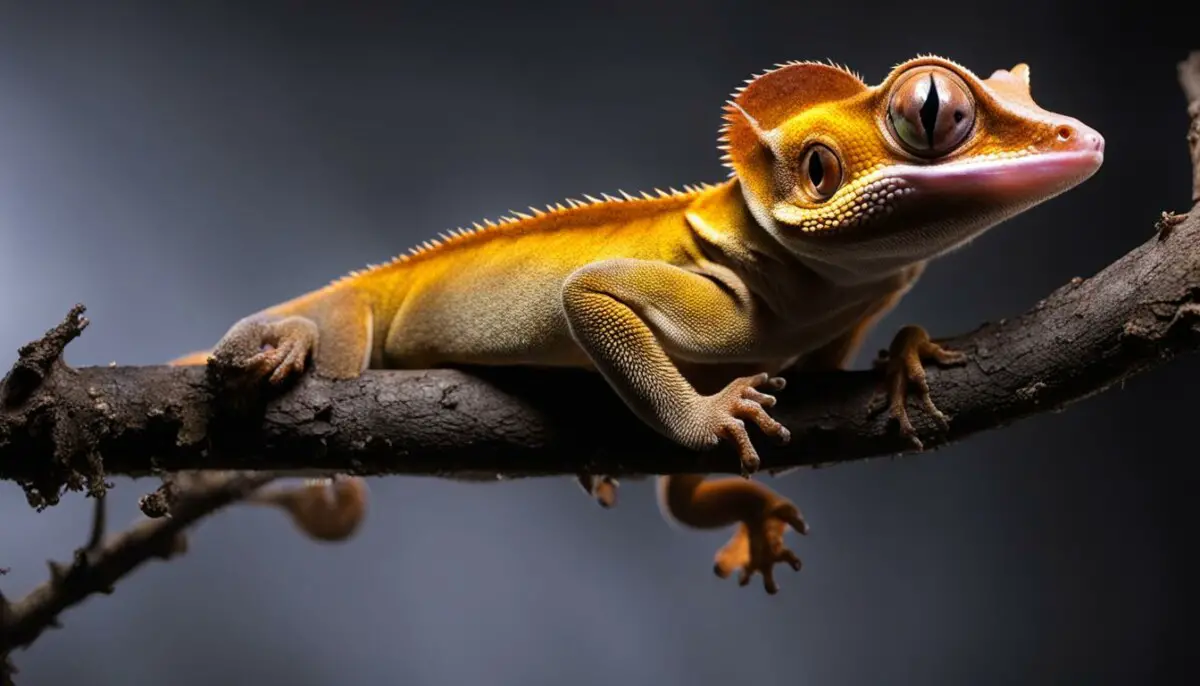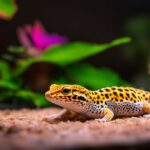Last Updated on 4 months by Francis
Crested geckos are fascinating creatures known for their unique characteristics. As nocturnal animals, they have exceptional night vision, allowing them to navigate their surroundings in low light conditions. However, a common question among reptile enthusiasts is whether crest geckos can see infrared.
While some animals have the ability to detect infrared light, such as certain snakes and insects, crested geckos do not possess this capability. Instead, they rely on their remarkable night vision to hunt for food and explore their environment.
Although they do not see infrared, it is essential to provide them with proper lighting to support their overall health and well-being. Artificial lighting can mimic the natural day/night cycle, promoting their sleep-wake cycle and stimulating natural behaviors.
Contents
Key Takeaways:
- Crested geckos do not have the ability to see infrared light.
- They rely on their excellent night vision to navigate in low light conditions.
- Proper lighting is crucial for their overall health and well-being.
- Artificial lighting helps regulate their sleep-wake cycle and promotes natural behaviors.
- LED lights that provide a day/night cycle are a recommended option.
The Importance of Lighting for Crested Geckos

Proper lighting is crucial for crested geckos to maintain their natural behaviors and overall health. While they do not have the ability to see infrared, they still benefit from having a day/night light cycle and access to low levels of UVB light. This helps regulate their sleep-wake cycle, promotes Vitamin D3 production, and stimulates natural behaviors like hunting and exploring their environment.
Crested geckos are nocturnal animals, meaning they are most active at night. In their natural habitat, they rely on moonlight and other ambient light sources to navigate and hunt for food. In captivity, it’s important to recreate these light cycles to ensure their wellbeing and promote their natural instincts.
Although crested geckos cannot detect infrared light, they have excellent night vision, allowing them to see well in low light conditions. Providing a dim light during the night helps maintain their natural circadian rhythm and allows them to feel secure in their enclosure. It’s important to avoid using bright lights or leaving the enclosure completely dark at night, as this can disrupt their sleep patterns and stress them out.
In addition to the day/night light cycle, access to UVB light is vital for crested geckos. UVB light helps with the synthesis of Vitamin D3 in their skin, which is essential for proper calcium metabolism and overall bone health. While crested geckos can obtain some Vitamin D3 from their diet, a lack of UVB light can lead to calcium deficiencies and serious health issues.
To provide the necessary UVB light, specialized reptile UVB bulbs can be used in the terrarium. It’s important to follow the manufacturer’s instructions regarding the distance between the bulb and the gecko, as well as the recommended duration of exposure. UVB bulbs should be replaced regularly according to the manufacturer’s guidelines to ensure they continue to emit adequate amounts of UVB light.
| Benefits of Proper Lighting for Crested Geckos |
|---|
| Promotes natural behaviors |
| Regulates sleep-wake cycle |
| Stimulates hunting and exploration |
| Supports Vitamin D3 production |
| Enhances overall health and wellbeing |
Having the right lighting setup for crested geckos is not only essential for their physical health but also contributes to their mental and emotional wellbeing. By replicating their natural light conditions and providing the necessary UVB light, you can help ensure that your crested gecko thrives in its environment.
Lighting Requirements for Crested Geckos

Crested geckos, while not having specific infrared detection abilities, rely on their excellent night vision to navigate their environment and find food in low-light conditions. To support their visual capabilities, it is important to provide a lighting setup that mimics their natural habitat.
Just like humans, crested geckos require access to various components of the electromagnetic spectrum, including UVB, UVA, visible light, and infrared. While they cannot directly sense infrared, these geckos have adapted to utilize their exceptional night vision to compensate for their lack of infrared detection abilities.
By creating a lighting environment that closely resembles their natural habitat, you can help optimize their visual capabilities. This includes providing a dim light at night to simulate the subdued lighting they would experience in the wild.
While crested geckos may not be able to detect infrared, their night vision allows them to excel in low-light conditions. Mimicking their natural environment with appropriate lighting can enhance their ability to navigate their enclosure and locate food sources.
Choosing the Right Lighting for Crested Geckos
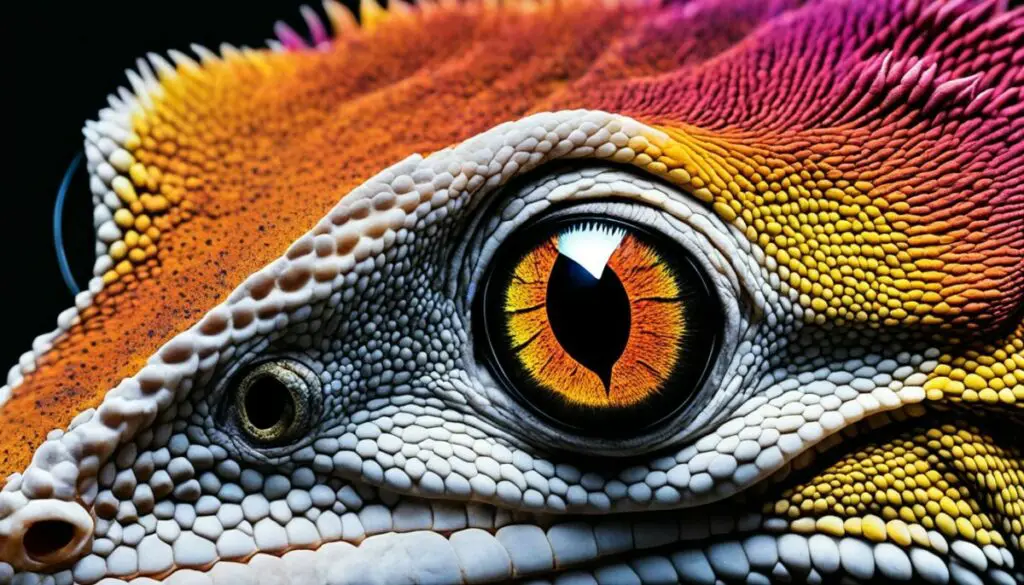
When it comes to ensuring the well-being of your crested geckos, providing the right lighting is essential. While crested geckos do not have the ability to see infrared, they have adapted to have excellent night vision. As a responsible owner, it’s important to consider their visual capabilities and natural habitat when selecting lighting options.
One recommended option for crested geckos is LED lights that provide a day/night cycle. LED lights offer a natural spectrum of light and do not emit heat, making them safe and energy-efficient. These lights also help simulate the natural lighting conditions that crested geckos would experience in the wild, promoting their overall well-being.
It’s crucial to avoid using infrared lights in crested gecko enclosures. While crested geckos cannot see infrared, they can detect it, which may disrupt their natural behaviors. Additionally, infrared lights can interfere with their night vision and affect their ability to navigate and hunt effectively.
Here’s an example of a lighting setup for a crested gecko enclosure:
| Lighting Component | Description |
|---|---|
| LED Lights | Provide a day/night cycle and mimic natural lighting conditions. Choose LED lights that emit a natural spectrum of light without heat. |
| UVB Bulbs | Help stimulate Vitamin D3 production in crested geckos, which is essential for calcium metabolism and bone health. |
| Dim Lighting | Ensure the enclosure has a dim light at night to support crested geckos’ night vision without causing disruption. |
By creating a lighting setup that includes LED lights with a day/night cycle, UVB bulbs, and dim lighting, you can provide the optimal lighting conditions for your crested geckos. Remember to consider the size of the enclosure and follow the manufacturer’s recommendations for fixture placement and light cycle to ensure the best results.
Creating a Lighting Setup for Crested Geckos
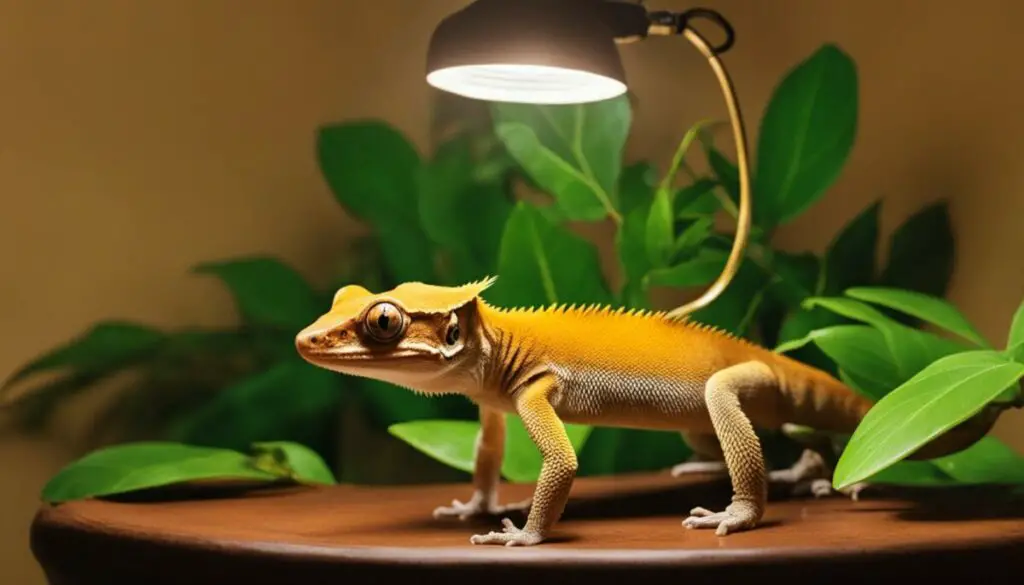
When setting up the lighting for your crested geckos, it’s essential to consider the size of their enclosure and choose the appropriate lighting system. By providing the right lighting, you can create an environment that supports their visual capabilities and overall well-being.
There are a few options to consider when it comes to lighting for crested geckos. UVB bulbs, fluorescent bulbs, and LED lights are commonly used to provide the necessary light spectrum for these reptiles. UVB bulbs help with Vitamin D3 production, while fluorescent bulbs and LEDs offer a natural spectrum of light that mimics the crested geckos’ natural habitat.
It’s crucial to follow the manufacturer’s recommendations for fixture placement and light cycles. These guidelines ensure that your crested gecko receives the right amount of light and darkness, promoting their natural behaviors and health. Placing the lighting fixtures at appropriate distances and angles within the enclosure will help create a balanced lighting setup.
Remember to avoid using infrared lights, as crested geckos do not have the ability to see infrared. By focusing on providing a natural light spectrum and following the manufacturer’s guidelines, you can create an optimal lighting setup for your crested gecko.
It’s also essential to consider the lighting needs of the plants and other decorative elements in the enclosure. Some plant species and types of habitats require specific lighting conditions. By taking these factors into account, you can create a well-balanced lighting setup that benefits both your crested gecko and their habitat.
Benefits of Lighting in a Crested Gecko Enclosure
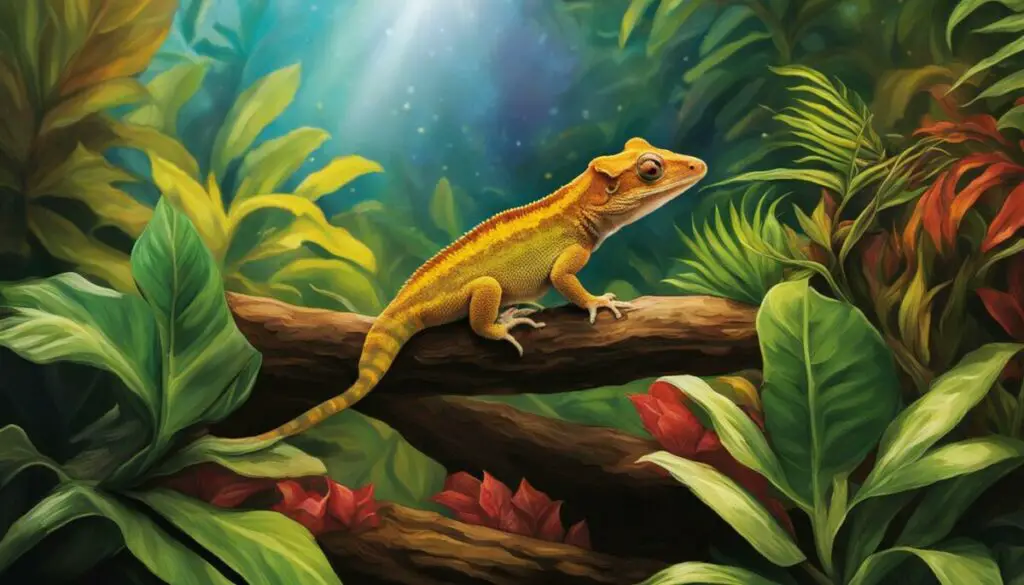
Proper lighting in a crested gecko enclosure offers several benefits. It not only creates a visually appealing environment but also plays a vital role in supporting their natural patterns and behaviors.
1. Maintaining Sleep-Wake Cycle: Adequate lighting helps regulate the sleep-wake cycle of crested geckos. By providing a day/night light cycle, you can mimic their natural environment, promoting healthy rest and activity patterns.
2. Promoting Natural Behaviors: Crested geckos are nocturnal creatures with excellent night vision. Proper lighting encourages their natural hunting behaviors and exploration of their surroundings, ensuring they stay engaged and active.
3. Stimulating Vitamin D3 Production: Crested geckos require access to low levels of UVB light to stimulate the production of Vitamin D3. This vitamin is essential for calcium metabolism and bone health, promoting their overall well-being.
4. Monitoring Health and Well-being: Sufficient lighting in the enclosure simplifies the observation and monitoring of a crested gecko’s health. You can easily spot any changes in their behavior, appetite, or physical appearance, allowing you to take prompt action if necessary.
As you can see, providing the right lighting setup not only benefits the crested geckos but also enhances your ability to care for them effectively. It’s essential to strike a balance with lighting to create an environment that replicates their natural habitat and supports their visual capabilities.
Common Lighting Mistakes to Avoid
When it comes to lighting for crested geckos, it’s important to be aware of some common mistakes that can negatively impact their well-being. By avoiding these errors, you can ensure that your crested gecko’s visual capabilities and overall health are effectively supported.
Using Daylight Lamps at Night
One common mistake is using daylight lamps as a source of light during the nighttime. While it may seem logical to provide additional brightness, using bright lamps at night can disrupt the crested gecko’s natural sleep-wake cycle. These nocturnal creatures require darkness and dim lighting during their active hours.
Avoiding UVC Lights
Another mistake to avoid is using UVC lights in your crested gecko’s enclosure. UVC lights emit ultraviolet C radiation, which can be harmful to their sensitive eyes. Exposure to UVC light can lead to eye damage and discomfort for your gecko. It’s best to stick to lighting options that do not emit UVC radiation.
Caution with Colored Nightlights
Colored nightlights may seem like a fun addition to your crested gecko’s enclosure, but it’s important to exercise caution. While crested geckos do not have the ability to see infrared, they can still see specific wavelengths of colored light. Certain colors can impact their behavior and may cause unnecessary stress. It’s best to stick to dim, neutral lighting options for nighttime viewing.
By avoiding these common mistakes and selecting the appropriate lighting setup for your crested gecko, you can create an environment that supports their visual capabilities and overall well-being.
Natural Lighting in the Wild vs. Artificial Lighting in Captivity

In the wild, crested geckos rely on natural lighting conditions, including dappled sunlight and moonlight, to navigate their environment. The mix of light and shadow helps them identify obstacles and locate prey. However, when kept in captivity, replicating these natural lighting conditions becomes essential to ensure their well-being.
Artificial lighting is necessary for captive crested geckos as it provides the necessary light cycles and helps regulate their sleep-wake cycle. While crested geckos do not have the ability to see infrared, their excellent night vision allows them to thrive in low-light conditions both in the wild and in captivity.
By providing a controlled lighting setup, crested geckos in captivity can still exhibit natural behaviors and regulate their internal clocks. This includes simulating a day/night light cycle and providing low levels of UVB light to support their health and stimulate natural behaviors.
While natural lighting conditions cannot be fully replicated in captivity, providing artificial lighting that mimics the natural environment as closely as possible is crucial for the well-being of crested geckos.
Benefits of Artificial Lighting in Captivity:
- Regulates sleep-wake cycle: Artificial lighting helps crested geckos establish a regular sleep schedule, promoting overall health and well-being.
- Stimulates natural behaviors: The proper light cycle and low levels of UVB light encourage crested geckos to exhibit natural behaviors, such as hunting and exploring their enclosures.
- Supports Vitamin D3 production: UVB light aids in the production of Vitamin D3, which is essential for calcium metabolism and bone health.
- Facilitates monitoring: Adequate lighting makes it easier for owners to observe and monitor their crested gecko’s health and behavior, enabling early detection of any issues.
Overall, while crested geckos cannot see infrared, providing artificial lighting in captivity is crucial to replicate natural lighting conditions and support their visual capabilities and overall well-being.
Recommended Lighting Options for Crested Geckos
When it comes to providing the right lighting for your crested gecko, there are several options to consider. These options include LED lights that offer a day/night cycle, UVB bulbs for optimal Vitamin D3 production, and dim lighting options for night viewing.
“Choosing the right lighting setup for your crested gecko is crucial for their overall health and well-being.”
Reputable brands such as Zoo Med and Exo Terra offer a variety of lighting fixtures that are suitable for crested geckos. These brands have a reputation for providing high-quality products that meet the specific needs of these reptiles. When selecting lighting options, consider the size of your crested gecko’s enclosure and the specific requirements of your pet.
Here are some recommended lighting options for your crested gecko:
- LED lights with a day/night cycle: These lights mimic natural lighting conditions and help establish a regular sleep-wake cycle for your crested gecko. Look for LED lights that provide both visible light and UVB light.
- UVB bulbs: UVB light is essential for crested geckos as it aids in Vitamin D3 production, which is necessary for calcium metabolism and overall bone health. Choose UVB bulbs specifically designed for reptiles.
- Dim lighting options: For night viewing, consider using dim lighting options that create a relaxing environment for your crested gecko. Avoid bright lights during the night, as this can disrupt their sleep patterns and natural behaviors.
It’s important to note that while crested geckos do not have the ability to see infrared, providing them with the right lighting setup ensures they can thrive in their captivity environment.
Comparison of Recommended Lighting Options
| Lighting Option | Benefits |
|---|---|
| LED lights with a day/night cycle |
|
| UVB bulbs |
|
| Dim lighting options |
|
By selecting the right lighting options for your crested gecko, you can ensure their visual capabilities are supported and their overall health is maintained.
Conclusion
While crested geckos do not possess the ability to see infrared light, they have remarkable night vision capabilities that enable them to navigate their surroundings in low light conditions. As nocturnal creatures, they have adapted to their natural environment, relying on their acute senses to explore and find prey. It is crucial for crested gecko owners to provide the right lighting setup to support their visual capabilities.
Creating a suitable lighting environment involves implementing a day/night cycle and ensuring access to low levels of UVB light. By mimicking their natural habitat with dim lighting at night, owners can help foster the crested gecko’s overall health and well-being. While they may not perceive infrared light, their excellent night vision compensates for this limitation, allowing them to thrive in low-light conditions.
By carefully selecting lighting fixtures from reputable brands such as Zoo Med and Exo Terra, crested gecko owners can create an optimal lighting setup for their pets. It is important to consider the size of the enclosure and the specific needs of the individual gecko when choosing the right lighting option. With the proper lighting environment in place, crested geckos can continue to exhibit their natural behaviors and flourish in captivity.
FAQ
Can crested geckos see infrared?
No, crested geckos do not have the ability to see infrared light like some other animals. However, they have excellent night vision and can navigate their surroundings in low light conditions.
Why is lighting important for crested geckos?
Lighting is important for crested geckos as it helps regulate their sleep-wake cycle, promotes Vitamin D3 production, and stimulates natural behaviors like hunting and exploring their environment.
Do crested geckos have infrared vision?
No, crested geckos do not have infrared vision. While they have excellent night vision, they do not have the specific ability to detect infrared light.
Can crested geckos detect infrared?
No, crested geckos cannot detect infrared light. They rely on their excellent night vision to navigate and find food in low-light conditions.
What lighting setup should I provide for my crested gecko?
It is recommended to provide a lighting setup that mimics the crested gecko’s natural environment with a day/night light cycle. LED lights that emit a dim light at night are a good option.
What are the benefits of proper lighting in a crested gecko enclosure?
Proper lighting promotes natural patterns and behaviors, such as maintaining the sleep-wake cycle and engaging in hunting behaviors. It also stimulates Vitamin D3 production for calcium metabolism and bone health.
What are common lighting mistakes to avoid for crested geckos?
It is important to avoid using daylight lamps at night, as they can disrupt the crested gecko’s sleep-wake cycle. UVC lights should also be avoided as they can be harmful to their eyes. Colored nightlights should be used with caution as crested geckos may still be able to see certain wavelengths, affecting their behavior.
How does natural lighting in the wild compare to artificial lighting in captivity for crested geckos?
In the wild, crested geckos rely on natural lighting conditions with dappled sunlight and moonlight. In captivity, artificial lighting is necessary to replicate these conditions and provide the necessary light cycles for their well-being.
What are some recommended lighting options for crested geckos?
Reputable brands such as Zoo Med and Exo Terra offer a variety of lighting fixtures suitable for crested geckos. LED lights that provide a day/night cycle, UVB bulbs, and dim lighting options for night viewing are recommended.
Can crested geckos sense infrared?
No, crested geckos do not have the ability to sense or detect infrared light.

